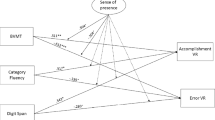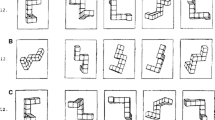Abstract
The user experience of Virtual Reality (VR) is a holistic experience related to internal and external aspects of users. Depth cues, which form depth perception, play an important role in enabling users not only to perceive the three-dimensional Virtual Environment (VE) from the two-dimensional surface but also to make interacts in the VE accurately. Spatial Presence (SP), a cognitive feeling of being there, addresses user’s mental models related to the mediated environment. We assume that SP would have moderating effects on the relationship between depth cues and user performance of VR. We examine it through a user study. Considering the depth cue as an independent variable, participants are exposed to two experimental conditions: non-depth cue condition and depth cue provided condition. As moderator variables, Self-Location and Possible Action, a two-dimensional structure of spatial presence, are measured by a questionnaire. Task completion time is considered as a dependent variable. The results show that in high self-location situations, depth cues are not as useful, but they play an important role in low self-location situations.
Access this chapter
Tax calculation will be finalised at checkout
Purchases are for personal use only
Similar content being viewed by others
References
Burdea, G.C., Coiffet, P.: Virtual Reality Technology. Wiley, New Jersey (2003)
Bryson, S.: Virtual reality in scientific visualization. Commun. ACM 39(5), 62–71 (1996)
Sherman, W.R., Craig, A.B.: Understanding Virtual Reality: Interface, Application, and Design. Elsevier, San Francisco (2002)
Cutting, J.E.: How the eye measures reality and virtual reality. Behav. Res. Methods Instrum. Comput. 29(1), 27–36 (1997)
Hu, H.H., Gooch, A.A., Thompson, W.B., Smits, B.E., Rieser, J.J., Shirley, P.: Visual cues for imminent object contact in realistic virtual environment. In: Proceedings of the Conference on Visualization. IEEE Computer Society Press (2000)
Wann, J., Mon-Williams, M.: What does virtual reality NEED? Human factors issues in the design of three-dimensional computer environments. Int. J. Hum Comput Stud. 44(6), 829–847 (1996)
IJsselsteijn, W., de Ridder, H., Hamberg, R., Bouwhuis, D., Freeman, J.: Perceived depth and the feeling of presence in 3DTV. Displays 18(4), 207–214 (1998)
Biocca, F., Delaney, B.: Immersive virtual reality technology. Commun. Age Virtual Reality 15, 32 (1995)
Barfield, W., Zeltzer, D., Sheridan, T., Slater, M.: Presence and performance within virtual environments. In: Virtual Environments and Advanced Interface Design, pp. 473–513 (1995)
Nash, E.B., Edwards, G.W., Thompson, J.A., Barfield, W.: A review of presence and performance in virtual environments. Int. J. Hum. Comput. Interact. 12(1), 1–41 (2000)
Wirth, W., Hartmann, T., Böcking, S., Vorderer, P., Klimmt, C., Schramm, H., Saari, T., Laarni, J., Ravaja, N., Gouveia, F.R., Biocca, F.: A process model of the formation of spatial presence experiences. Media Psychol. 9(3), 493–525 (2007)
Schubert, T.W.: A new conception of spatial presence: once again, with feeling. Commun. Theor. 19(2), 161–187 (2009)
Vorderer, P., Wirth, W., Gouveia, F.R., Biocca, F., Saari, T., Jäncke, F., Böcking, S., Schramm, H., Gysbers, A., Hartmann, T., Klimmt, C.: MEC spatial presence questionnaire (MEC-SPQ): short documentation and instructions for application. Report to the European community, project presence: MEC (IST-2001-37661), 3 (2004)
Weibel, D., Wissmath, B.: Immersion in computer games: the role of spatial presence and flow. Int. J. Comput. Games Technol. 6 (2011)
Tamborini, R., Skalski, P.: The role of presence in the experience of electronic games. In: Playing Video Games: Motives, Responses, and Consequences, pp. 225–240 (2006)
Reichelt, S., Häussler, R., Fütterer, G., and Leister, N.: Depth cues in human visual perception and their realization in 3D displays. In: Three-Dimensional Imaging, Visualization, and Display 2010 and Display Technologies and Applications for Defense, Security, and Avionics IV. International Society for Optics and Photonics (2010)
Howard, I.P., Rogers, B.J.: Seeing in depth. Volume 2: Depth Perception. Canada: I. Porteous, Ontario (2002)
Hayes, A.F.: Introduction to Mediation, Moderation, and Conditional Process Analysis: A Regression-Based Approach. The Guilford Press, New York (2013)
Acknowledgments
This work was supported by the National Research Foundation of Korea (NRF) grant funded by the Korea government (MSIP; Ministry of Science, ICT & Future Planning) (NRF-2017R1C 1B 1003650).
This research was supported by the MIST (Ministry of Science and ICT), Korea, under the National Program for Excellence in SW supervised by the IITP (Institute for Information & communications Technology Promotion) (2015-0-00914).
Author information
Authors and Affiliations
Corresponding author
Editor information
Editors and Affiliations
Rights and permissions
Copyright information
© 2019 Springer Nature Switzerland AG
About this paper
Cite this paper
Ahn, S., Sah, Y.J., Lee, S. (2019). Moderating Effects of Spatial Presence on the Relationship Between Depth Cues and User Performance in Virtual Reality. In: Lee, S., Ismail, R., Choo, H. (eds) Proceedings of the 13th International Conference on Ubiquitous Information Management and Communication (IMCOM) 2019. IMCOM 2019. Advances in Intelligent Systems and Computing, vol 935. Springer, Cham. https://doi.org/10.1007/978-3-030-19063-7_27
Download citation
DOI: https://doi.org/10.1007/978-3-030-19063-7_27
Published:
Publisher Name: Springer, Cham
Print ISBN: 978-3-030-19062-0
Online ISBN: 978-3-030-19063-7
eBook Packages: Intelligent Technologies and RoboticsIntelligent Technologies and Robotics (R0)




